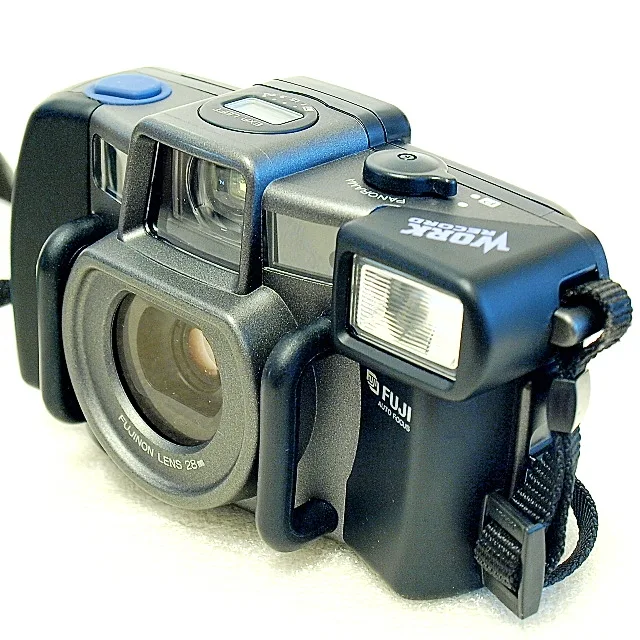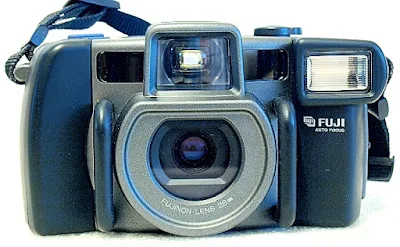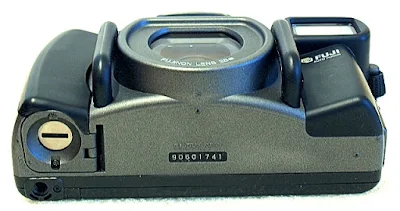The Fuji Work Record OP, different from its sibling the Work Record 28, came with a panorama feature and a quartz-date data back. Both cameras, however, have the same 6-element in 5-groups Fujinon 28mm F3.5 lens located behind a 4mm thick protective glass plate.
The panorama feature on the Work Record OP is switchable mid-roll, and the camera can be used underwater to a depth of 1 meter.
Common to all three cameras, the Genba Kantoku 28W, Fuji K-28, and the Work Record OP, and why I collect them, is the fact that all three are fitted with wide-angle 28mm lenses, the street shooter's delight. On top of that, their ruggedized weatherproof construction exemplifies the ability of these cameras to be used in the rain or shine, in the rough and tough, or in places where you might not want to take a non-weatherproof camera.
FUJI WORK RECORD
Uploaded by Chris Maklai on 2019-05-19.
The work Record OP has a blue shutter button, a chunky panorama switch on the left of the top plate, and a quartz date panel on the film back. The Work Record 28, on the other hand, does not have these functions and comes with an orange shutter release button. Both cameras were in production from 1993 to 2006.
Camera Operation
Operation on the Fuji Work Record OP, the same as on the K28, is electronic. The camera has a programmable shutter speed range from 1/5 to 1/250 seconds, and film sensitivity is DX-coded with an ISO range from 50 to 1600. The lens, as mentioned earlier, is a Fujinon 28mm F3.5.
At 385 grams of body weight, sans the battery, the Fuji Work Record OP is still lightweight and compact enough to fit into your sling bag or carry it hanging by the neck strap.
Basic Camera Features
The Work Record OP is a bit of a technical wonder for a camera of its time. Physically, the camera is reminiscent of the Fuji GS645S, the medium format camera with a lens housing protected by a circular 'bull bar'. On the Work Record, the bar is a pair that extends out on each side of the sealed lens housing.
Located above the lens housing is an extra-large Albada-type Bright Frame viewfinder with Panorama size switching, autofocus spot, and close-focus parallax adjustment lines. The viewfinder is designed to be bright and easy to see through, even in the dark.
On each side of the viewfinder is a pair of AF sensor windows with a small 10-second self-timer LED located within the left (looking from the front) sensor window.
The high-powered built-in flash unit, located on the top right corner of the front plate, can reach up to 14 meters with ISO 400 film installed. The flash can be set to auto, low brightness, flash off, and fill-in. The indicator lamp will light up in low-brightness auto flash mode.
From the top, looking from right to left, is the mandatory shutter release button on the right, an LED display panel on top of the viewfinder housing, and the panorama selector knob switch to the left.
Camera Mode display, which will be shown on the LCD panel, includes Power On/Off indicator, self-timer mode, film frame counter, flash modes (charging, daytime flash, strobe off), backlight compensation mode, and battery strength indicator.
On the back of the camera is the viewfinder window, with a pair of LEDs to indicate focus lock (Green) and flash recommended (Red) conditions. A flashing Green LED means that the camera's autofocusing is unable to lock on a specific subject.
The quartz-date display setting panel and film check window are on the film itself.
Access to the battery chamber, which requires a pair of CR123 lithium batteries to power the operations of the camera, is on the bottom plate, accessible via a turn-lock-hinged flap. Used economically, the batteries should last far longer than half a dozen pairs of alkaline batteries.
Other than that, there is also the tripod socket, which is located rather precariously on the right back bottom corner of the bottom plate.
The film box is almost the standard intuitive quick-load affair, which is common to almost all film cameras manufactured in that era. The film back latch-lock is on the left side of the camera body, which opens and closes the camera back with a snap.
Film Forward and Rewind
Film loading, film forward, and rewind at the end of the film roll are motorized. All you have to do is drop the film canister in the DX-pinned chamber and pull the film tab to the right edge of the film box before closing the film back.
The Fuji Work Record OP is one of the other cameras that I have come across that forwards the whole roll of the film up to frame 36 into the spool chamber and returns exposed frames back into the film canister as you go down the frame counter. This, of course, helps to preserve almost all of your exposed frames if or when the film back is accidentally opened.
Panorama Mode
The panorama mode of the Fuji Work OP is a cropped-frame implementation, where a pair of blinds is used to reduce the height of the film frame. Switching from normal full-frame shooting mode to panorama shooting with a turn of the panorama selector switch located on the top plate can be done on the fly, i.e., anytime you want it done.
Flash Mode Selector
The flash mode selector, the top buttons located under the power switch flap, cycles between Auto Flash, Flash ON, Flash OFF, and Backlight compensation mode. Auto flash is the default mode when the camera is powered on, indicated only by a red LED display in the viewfinder when activated.
The Flash ON, Flash OFF, and Flash recharging icons are displayed on the right of the LCD display panel, while the Backlight compensation mode icon is displayed on the left of the display. Flash charging time is approximately 5 seconds, and flash charging is normally activated automatically when the camera is powered on.
Self Timer
The 10-second self-timer mode is activated by the middle button located under the power switch flap. The icon display is in the top left corner of the LCD panel.
Switching To Zone (Manual) Focusing
One unique feature of the Work Record OP is the ability to switch from auto to manual focusing mode at pre-set distances of 1, 1.5, and 3 meters, and landscape (infinity focus). This can happen when you are faced with a situation where you cannot get the camera's autofocus to lock, or when you prefer manual focusing for that panoramic landscape shot.
The mode selector button for this function is the lowest of the three buttons that are located behind the Power On/Off flap. Setting the zone focusing to infinity will also disable the auto flash.
The zone focusing distance, including landscape (infinity focus), will be displayed on the bottom row of the LCD display panel just above the engraved distance numerals.
Zone or hyperfocal focusing is the recommended mode when you are shooting underwater, or, for example, when shooting through the glass front of an aquarium tank.
Using The Camera
At the end of the day, of course, the camera is just another 28mm AF auto-exposure street shooter. The advantage, however, is the camera's ruggedized and waterproof construction with rigid rubber protectors and coated 4mm optical glass that protects the lens.
A little spill in the mud and sand will do the camera no harm; just wash the mud and sand off, and you are ready to shoot again.
Had my fun with the camera, and enjoyed shooting with it, and between the three mentioned in this article, I will probably keep the Work Record OP the longest, or until a film 28-56mm zoom or a film 28mm/45mm twin arrives for me to compare it with.
I was using an expired roll of Fujifilm Superia 200 for these shots. Images were inherently quite soft but were picked up and enhanced on Olympus Viewer 3 (OV3) and print sharpened on Google NIK Sharpener Pro 3.
Resource Links:
Neither the Fuji Work Record 28 nor the Fuji Work Record OP is sold outside of Japan, making it almost impossible to get any resources in English for these cameras aside from what is available on Camera-wiki, a couple of videos on YouTube, and a post on the MF lenses forum.
I was lucky enough to gain some access to a couple of web pages written in Japanese, which provided me enough information to be able to come up with this page, which is here, and the other is from the Fujifilm website itself.
Thank you.


























No comments:
Post a Comment